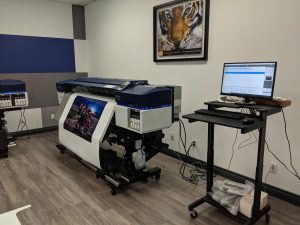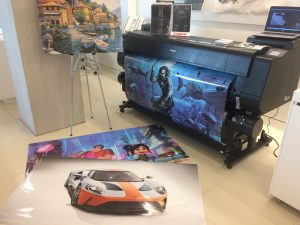A how-to guide on leveraging wide-format opportunities

With today’s technologies almost any surface can carry a message or image printed on a large format digital device. Photos by Jason Cramp
By Lisa Cross, Eve Padula and Steve Urmano
Signs, displays and special graphic applications are powerful communication tools, compelling marketing tools and effective decoration enhancers. Ongoing innovations in inkjet printing technologies, inks and substrates are expanding application possibilities and driving revenue growth for large format suppliers.
Large format printing applications are ubiquitous and their use is constantly increasing. Traditional applications that most people are familiar with include banners, vehicle graphics, signs, window graphics and backlit displays to name a few. Newer applications include wallpaper, textile signage, industrial products and apparel, and this list of viable applications continues to grow.
Understand key opportunities
Wide format applications dominate the visual landscape. With today’s technologies almost any surface can carry a message or image printed on a large format digital device. Although the possible uses are endless, they can be categorized into the following broad areas: outdoor graphics, indoor graphics, and point-of-purchase (POP) displays.
outdoor graphics encompass a variety of applications that are used outdoors and therefore need to withstand the elements. Typical applications are:
- building coverings and cladding.
- Flex Face billboards.
- Backlit signage (day and night).
- Banner/Fleet Graphics.
- vehicle wraps.
- Transit/information signage.
interior graphicas the name suggests, are used indoors and encompass a wide variety of uses that fall into the following categories:
- branding promotions.
- pop-up ads.
- posters.
- Backlit signage (day and night).
- Exhibition/Event Graphics.
- Floor/window graphics.
- Backdrops for theatre/TV.
- Photographic reproductions.
Point of Purchase (POP) Displays are marketing or advertising media that are placed next to the advertised goods. POP displays come in many varieties, including:
- Rigid POP displays.
- 3D POP displays.
- open packaging/displays; actions in business.
- Small batch packaging for prototyping.
- Short-run packaging for seasonal promotions and one-off events.

Continued advances in technology and ink are creating new opportunities to produce applications with higher profit margins and special print effects.
Trending applications
Ongoing innovations in inkjet printing devices, inks, coatings, substrates and finishing equipment are opening up many new and attractive application possibilities. The applications that can be produced on large format printers encompass a seemingly endless variety of applications and span many industries. Here is a summary of the trending applications:
Soft signage
Printed directly or via a transfer process onto fabric, soft signage is becoming increasingly attractive to customers due to the higher quality look and feel of the finished graphics. It’s easier to handle/hang, costs less shipping, is easily reused, and can be used with curved or framed structures.
Small batch packaging and prototyping
The combination of digital large format printing with digital cutting has enabled the cost-effective production of packaging and prototypes in short runs. Digitally printed packaging and labels offer brand managers the flexibility to produce smaller quantities for test markets, regional/ethnic products and seasonal offerings. Digital production eliminates expensive set-up costs and long lead times for last-minute special releases or personalized one-to-one packages.
thermoforming
This is another area of interest. Thermoforming involves heating a plastic substrate to a pliable temperature and using a mold to shape it into a specific shape. It is chilled and trimmed into a usable product. Brand owners, retailers, and manufacturers can use thermoforming to create custom molded 3D signs, packaging, POP displays, point-of-sale displays, gaming kiosks, and more. Digital printing directly onto these materials is much faster and less expensive – it eliminates costly and time-consuming screen/hand coating processes or pre-printing and laminating onto moldable plastics.
decor
Applications such as wallpaper, flooring, furniture and tile are growing as customers become more familiar with the ability of large format digital printing to enable shorter runs and shorter turnaround times for customized and “short run” requests.